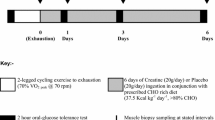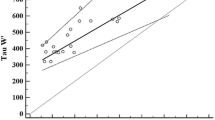Abstract
A single session of prolonged work was employed to investigate changes in selected metabolic, transporter and enzymatic properties in muscle. Ten active but untrained volunteers (weight = 73.9 ± 4.2 kg) with a peak aerobic power \( \left( {\dot{V}{\text{O}}_{{2{\text{peak}}}} } \right) \) of 2.95 ± 0.27 l min−1, cycled for 2 h at 62 ± 1.3% \( \left( {\dot{V}{\text{O}}_{{2{\text{peak}}}} } \right) \) Tissue extraction from the vastus lateralis occurred prior to (E1-Pre) and following (E1-Post) exercise and on 3 consecutive days of recovery (R1, R2, R3). The exercise resulted in decreases (P < 0.05) in ATP (−9.3%) and creatine phosphate (−49%) and increases in lactate (+100%), calculated free ADP (+253%) and free AMP (+1,207%), all of which recovered to E1-Pre by R1. Glycogen concentration, which was depressed (P < 0.05) by 75% at E1-Post, did not recover until R3. Compared to E1-Pre, the cycling also resulted in decreases (P < 0.05) in the activities of cytochrome c oxidase, phosphorylase, and hexokinase but not in citrate synthase (CS) or 3-hydroxy-CoA dehydrogenase at E1-Post. With the exception of CS, which was elevated (P < 0.05) at R3, all enzyme activities were not different from E1-Pre during recovery. For the glucose (GLUT1, GLUT4) and monocarboxylate (MCT1, MCT4) transporters, changes in expression levels (P < 0.05) were only observed for GLUT1 at R1 (+42%) and R3 (+33%). It is concluded that the metabolic stress produced by prolonged exercise is reversed by 1 day of recovery. One day of exercise also resulted in a potential upregulation in the citric acid cycle and glucose transport capabilities, adaptations which are expressed at variable recovery durations.



Similar content being viewed by others
References
Allen DG, Lamb AG, Westerblad H (2008a) Impaired calcium release during fatigue. J Appl Physiol 104:296–305
Allen DG, Lamb GD, Westerblad H (2008b) Skeletal muscle fatigue: cellular mechanisms. Physiol Rev 88:287–332
Bergström J (1962) Muscle electrolytes in man. Scand J Clin Lab Invest 14(Suppl 68):1–110
Bonen A, McCullagh KJA, Putnam CT, Hultman E, Jones NL, Heigenhauser GJF (1998) Short-term training increases human muscle MCTI and femoral venous lactate in relation to muscle lactate. Am J Physiol 274:E102–E107
Coffey VG, Hawley JA (2007) The molecular basis of training adaptation. Sports Med 37:737–763
Costill DL (1985) Carbohydrate nutrition before, during and after exercise. Fed Proc 44:364–368
Duhamel TA, Green HJ, Perco JG, Ouyang J (2006a) Effects of prior exercise and a low-carbohydrate diet on muscle sarcoplasmic reticulum function during cycling in women. J Appl Physiol 101:695–706
Duhamel TA, Perco JG, Green HJ (2006b) Manipulation of dietary carbohydrates after prolonged effort modifies muscle sarcoplasmic reticulum responses in exercising males. Am J Physiol Regul Integr Comp Physiol 291:R1100–R1110
Duhamel TA, Stewart RD, Tupling AR, Ouyang J, Green HJ (2007) Muscle sarcoplasmic reticulum calcium regulation during consecutive days of exercise and recovery. J Appl Physiol 103:1212–1220
Dutka TL, Lamb GD (2007) Na+-K+ pumps in the transverse tubular system of skeletal musle fibers preferentially use ATP from glycolosysis. Am J Physiol 293:C967–C977
Flück M (2006) Functional, structural and molecular plasticity of mammalian skeletal muscle in response to exercise stimuli. J Exp Biol 209:2239–2248
Gibala MJ, Little JP, van Essen M, Wilkin GP, Burgomaster KA, Safdar A et al (2006) Short term interval versus traditional endurance training: similar initial adaptations in human skeletal muscle and exercise performance. J Physiol 575(3):901–911
Green HJ, Duhamel TA, Foley KP, Ouyang J, Smith IC, Stewart RD (2007a) Glucose supplements increase human muscle Na+-K+-ATPase activity in vitro during prolonged exercise. Am J Physiol 293:R354–R362
Green HJ, Duhamel TA, Holloway GP, Moule J, Ouyang J, Ranney D et al (2007b) Muscle metabolic responses during 16 hours of heavy intermittent exercise. Can J Physiol Pharmacol 85:634–645
Green HJ, Bombardier E, Duhamel TA, Stewart RD, Tupling AR, Ouyang J (2008a) Metabolic, enzymatic and transporter responses in human muscle to consecutive days of exercise and recovery. Am J Physiol 295:R1238–R1250
Green HJ, Duhamel T, Holloway GP, Moule JW, Ranney D, Tupling AR et al (2008b) Rapid upregulation of GLUT4 and MCT4 expression during sixteen hours of heavy intermittent cycle exercise. Am J Physiol 294:R594–R600
Green HJ, Duhamel TA, Stewart RD, Tupling AR, Ouyang J (2008c) Dissociation between changes in muscle Na+-K+-ATPase isoform abundance and activity with consecutive days of exercise and recovery. Am J Physiol 294:E761–E767
Green HJ, Bombardier E, Duhamel TA, Holloway GP, Tupling AR, Ouyang J (2008d) Acute reductions in muscle mitochondrial and cytosolic enzyme activities during heavy intermittent exercise. J Appl Physiol 104:931–937
Green HJ, Duhamel TA, Smith IC, Rich SM, Thomas MM, Ouyang J et al. (2010a). Muscle metabolic, enzymatic and transporter responses to a session of prolonged exercise. Eur J Appl Physiol (submitted June)
Green HJ, Duhamel TA, Smith IC, Rich SM, Thomas MM, Ouyang J et al. (2010b). Muscle mechanical and excitation-contraction coupling responses to a session of prolonged cycling. Exp Physiol (submitted June)
Hardie DG, Hawley SA, Scott JW (2006) AMP-activated protein kinase—development on an energy sensor concept. J Physiol 574:7–15
Henriksson JM, Chi MY, Hintz CS, Young DA, Kaiser KK, Salmons S et al (1986) Chronic stimulation of mammalian muscle: changes in enzymes of six metabolic pathways. Am J Physiol 251:C614–C632
Holloszy JO (2003) A forty-year memoir of research on the regulation of glucose transport into muscle. Am J Physiol 284:E453–E467
Hultman E, Bergström J, Roch-Norland AE (1971) Glycogen storage in human skeletal muscle. Acta Med Scand 182:109–117
Ingebretson DC, Bakken AM, Segadal L, Farstad M (1982) Determination of adenine nucleotides and inosine in human myocardium by ion pair reversed phase high performance liquid chromatography. J Chromatogr 242:119–126
Ji L-L (1995) Oxidative stress during exercise: implications of antioxidant nutrients. Free Radic Biol Med 18:1079–1086
Ji L-L, Stratman FW, Lardy HA (1988) Enzymatic down regulation with exercise in rat skeletal muscle. Arch Biochem Biophys 263:137–149
Juel C (2006) Training-induced changes in membrane transport proteins of human skeletal muscle. Eur J Appl Physiol 96:627–635
Klip AK, Schertzer JD, Bilan PJ, Thong F, Antonescu C (2009) Regulation of glucose 4 traffic by energy deprivation from mitochondrial compromise. Acta Physiol Scand 196:27–35
Lamb GD (2009) Mechanisms of excitation–contraction coupling relevant to activity-induced muscle fatigue. Appl Physiol Nutr Metab 34:368–372
Lowry OH, Passonneau JV (1972) A flexible system of enzymatic analysis. Academic Press, New York
Mahoney DJ, Parise G, Melov S, Safdar A, Tarnopolsky MA (2005) Analysis of global mRNA expression in human skeletal muscle during recovery from endurance exercise. FASEB 19:1498
McBride A, Hardie DG (2009) AMP-activated protein kinase—a sensor of glycogen as well as AMP and ADP? Acta Physiol 196:99–113
McKenna MJ, Bangsbo J, Renaud JM (2008) Muscle K+, Na+, and Cl− disturbances and Na+-K+ pump inactivation: implications for fatigue. J Appl Physiol 104:288–295
Meyer RA, Foley JM (1996) Cellular processes integrating the metabolic response to exercise. In: Rowell L, Shephard J (eds) Handbook of Physiology. Exercise: Regulation and Integration of Multiple Systems. Oxford University Press, New York, pp 841–869
Mollica JP, Oakhill JS, Lamb GD, Murphy RM (2009) Are genuine changes in protein expression being overlooked? Reassessing western blotting. Anal Biochem 386:270–275
O’Doherty RM, Bracy D, Osawa H, Wasserman D, Cranner DK (1994) Rat skeletal muscle hexokinase II mRNA and activity are increased by a single bout of acute exercise. Am J Physiol 266:E171–E178
O’Doherty RM, Bracy DP, Granner DK, Wasserman DH (1996) Transcription of the rat skeletal muscle hexokinase II gene is increased by acute exercise. Am J Physiol 81:789–793
Okamoto K, Wang W, Rounds J, Chambers EA, Jacobs DO (2001) ATP from glycolysis is required for normal sodium homeostasis in resting fast-twitch rodent skeletal muscle. Am J Physiol 281:E479–E488
Reid MB, Durham WJ (2002) Generation of reactive oxygen and nitrogen species in contracting skeletal muscle: potential impact in aging. Ann N Y Acad Sci 959:108–116
Sahlin K, Palmskog G, Hultman E (1978) Adenine nucleotides and IMP contents of the quadriceps muscle in man after exercise. Pflügers Arch 374:193–198
Schacterle GR, Pollock RL (1973) A simplified method for the quantitative assay of small amounts of protein in biologic material. Anal Biochem 51:654–655
Shearer J, Graham T (2002) New perspectives on the storage and organization of muscle glycogen. Can J Appl Physiol 27:179–203
Spencer MK, Yan Z, Katz A (1991) Carbohydrate supplementation attenuates IMP accumulation in human muscle during prolonged exercise. Am J Physiol 261:C71–C76
Stephenson DG, Nguyen LT, Stephenson GMM (1999) Glycogen content and excitation-contraction coupling in mechanically skinned muscle fibres of the cane toad. J Physiol (Lond.) 519:177–187
Stewart RD, Duhamel TA, Rich S, Tupling RA, Green HJ (2008) Effects of consecutive days of exercise and recovery on mechanical function. Med Sci Sports Exerc 40:316–325
Thorens R, Mueckler M (2010) Glucose transporters in the 21st Century. Am J Physiol 298:E141–E145
Tupling AR (2004) The sarcoplasmic reticulum in muscle fatigue and disease: role of sarco(endoplasmic) reticulum Ca2+-ATPase. Can J Appl Physiol 29:330–356
Tupling AR (2009) The decay phase of Ca2+-transients in skeletal muscle: regulation and physiology. Appl Physiol Nutr Metab 34:368–372
Xu K, Zweier J, Becker L (1995) Functional coupling between glycolysis and sarcoplasmic reticulum Ca2+-transport. Circ Res 77:88–97
Acknowledgments
We acknowledge the financial support provided by the Natural Science and Engineering Research Council (Canada) for the research (to H. Green).
Author information
Authors and Affiliations
Corresponding author
Additional information
Communicated by Susan Ward.
Rights and permissions
About this article
Cite this article
Green, H.J., Duhamel, T.A., Smith, I.C. et al. Muscle metabolic, enzymatic and transporter responses to a session of prolonged cycling. Eur J Appl Physiol 111, 827–837 (2011). https://doi.org/10.1007/s00421-010-1709-y
Accepted:
Published:
Issue Date:
DOI: https://doi.org/10.1007/s00421-010-1709-y




